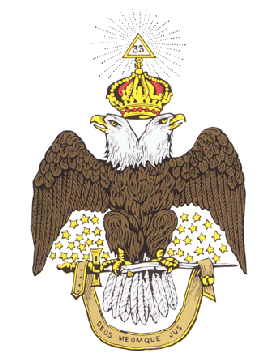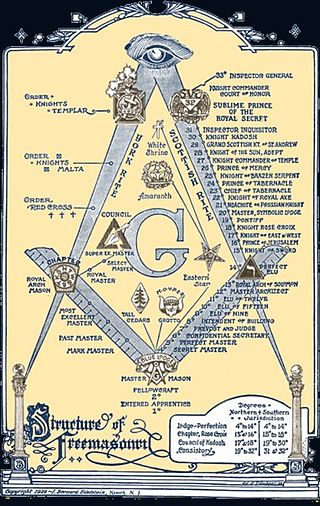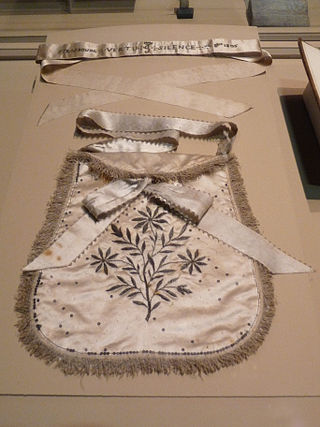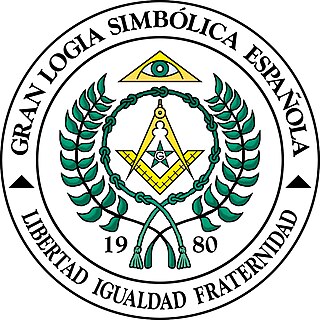
Freemasonry or simply Masonry includes various fraternal organisations that trace their origins to the local guilds of stonemasons that, from the end of the 14th century, regulated the qualifications of stonemasons and their interaction with authorities and clients. Freemasonry is the oldest fraternity in the world and among the oldest continued organizations in history.

The Ancient and Accepted Scottish Rite of Freemasonry is a rite within the broader context of Freemasonry. It is the most widely practiced Rite in the world. In some parts of the world, and in the Droit Humain, it is a concordant body and oversees all degrees from the 1st to 33rd degrees, while in other areas, a Supreme Council oversees the 4th to 33rd degrees.
In Anglo-American Freemasonry, York Rite, sometimes referred to as the American Rite, is one of several Rites of Freemasonry. It is named after York, in Yorkshire, England, where the Rite was supposedly first practiced.
The history of Freemasonry encompasses the origins, evolution and defining events of the fraternal organisation known as Freemasonry. It covers three phases. Firstly, the emergence of organised lodges of operative masons during the Middle Ages, then the admission of lay members as "accepted" or "speculative" masons, and finally the evolution of purely speculative lodges, and the emergence of Grand Lodges to govern them. The watershed in this process is generally taken to be the formation of the first Grand Lodge in London on the Gregorian 24 June 1717. The two difficulties facing historians are the paucity of written material, even down to the 19th century, and the misinformation generated by masons and non-masons alike from the earliest years.
A Grand Lodge, also called Grand Orient or by another similar title, is a name for the overarching governing body of a fraternal or other similarly organized group in a given area, usually a city, state, or country.

There are many organisations and orders which form part of the widespread fraternity of Freemasonry, each having its own structure and terminology. Collectively these may be referred to as Masonic bodies, Masonic orders, Concordant bodies or appendant bodies of Freemasonry.
This is a general survey on the historical and modern presence of Freemasonry in countries located in Asia.

Freemasonry has had a complex relationship with women for centuries. A few women were involved in Freemasonry before the 18th century, despite de jure prohibitions in the Premier Grand Lodge of England.
Liberal Freemasonry, also known as Continental Freemasonry or Adogmatic Freemasonry, is a major philosophical tradition within Freemasonry that emphasizes absolute freedom of conscience, philosophical inquiry, and progressive social values. Liberal Freemasonry is characterized by its acceptance of all people regardless of religious belief, gender, or philosophical outlook. It represents one of the two main branches of modern Freemasonry, alongside Conservative (Anglo-American) Freemasonry. The Liberal tradition emerged primarily in France during the Age of Enlightenment and came to full expression through the Grand Orient de France's 1877 adoption of absolute freedom of conscience as a founding principle. Today, Liberal Freemasonry is the predominant form of Freemasonry in Continental Europe, Latin America, and parts of Africa, with millions of members worldwide organized in various grand lodges and masonic bodies.
Freemasonry in France has been influential on the worldwide Masonic movement due to its founding of Continental Freemasonry.

The Grand Lodge of Free & Accepted Masons of Indiana is one of two statewide organizations that oversee Masonic lodges in the state of Indiana. It was established on January 13, 1818. In 2016 the number of Freemasons in the Grand Lodge of Indiana was 55,553 amongst its 394 separate lodges, currently making it the sixth largest Masonic jurisdiction in the U.S. The Grand Lodge of Indiana's offices and archives are located in the Indianapolis Masonic Temple. The historically black Most Worshipful Prince Hall Grand Lodge of Indiana F&AM is the second regular Masonic grand lodge in the state, and it was originally established in 1856 as the Independent Union Grand Lodge of Free and Accepted Masons of the State of Indiana. The two grand lodges agreed to mutual recognition in May 1998, and they jointly share sovereignty over the Masonic fraternity in Indiana.
Continental or Liberal Freemasonry in North America encompasses the rich tapestry of Masonic lodges and Grand Lodges across the United States, Canada and Mexico that embrace the principles of the liberal masonic tradition. In contrast to the conservative tradition, Liberal Freemasonry welcomes a broader spectrum of beliefs, genders, and philosophical perspectives.
The history of Freemasonry in Mexico can be traced to at least 1806 when the first Masonic lodge was formally established in the nation.
The Grand Lodge of Chile is a regular Masonic body in Chile founded on May 24, 1862. The earthquake of 1906 destroyed the original headquarters and the archives of the Grand Lodge, which determined its definitive transfer to Santiago, settling in the Club de la República.
Freemasonry in Spain is first recorded in 1728, in an English lodge. As various papal bulls condemned Freemasonry the Spanish Inquisition did their best to close lodges and demonise Freemasons, therefore the success of Freemasonry from year to year depended on the sympathy or antipathy of the ruling regime. Nevertheless, lodges and even Grand Lodges were formed, and even thrived during more liberal periods. When Francisco Franco consolidated power in 1939, all Freemasonry was banned. In 1979, four years after Franco's death, bans on Freemasonry were declared unconstitutional, and several Grand Lodges and Orients now flourish in Spain.

Freemasonry in Luxembourg traces its local origins to the 18th century. Though the practice of Freemasonry was suppressed by the reigning Austrian Habsburg dynasty, it enjoyed a revival under Napoleonic rule that persisted after the close of his reign. After their initial founding, Masonic lodges in Luxembourg rapidly developed strong ties with their French and Belgian counterparts. While suppressed again under Nazi rule, postwar Freemasonry forged stronger ties with the Anglo-American extension of the brotherhood, though the oldest lodges still use the French form of Masonic ritual.

The Symbolic Grand Lodge of Spain is one of the main grand obediences in Spain. It is one of group of obediences included in CLIPSAS, and can be defined as a mixed or egalitarian, liberal and non-dogmatic Grand Lodge.

Freemasonry begins in Costa Rica at the same time as in Central America during the course of the 19th century. Regular masonry begins when it was founded by Costa Rican Catholic priest Francisco Calvo, ex-Chaplain General of the Army of Costa Rica during the Filibuster War of 1856, who introduced regular masonry in Central America in 1865. However, there is evidence of the existence of "non-regular" Lodges active after the Independence and before. Prominent Costa Rican figures of politics, literature, art and science, including several presidents of the Republic, were Freemasons.

Freemasonryin Latin America has a prominent presence, with many Masonic lodges and members across the region. In terms of membership, it is the most densely populated geographical area after the United States. It manifests in many different forms, and as of 2017, its overall history remains to be fully established. Nevertheless, Freemasonry is frequently referenced in the historical accounts of these countries, particularly concerning the considerable number of Freemasons who played a role in the independence movements against Spain and Portugal.











